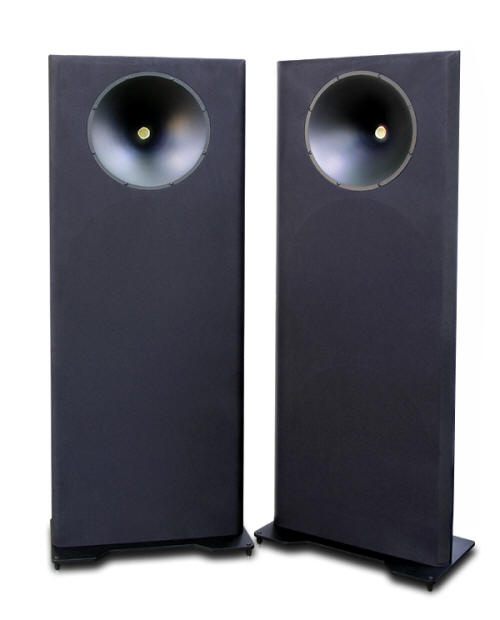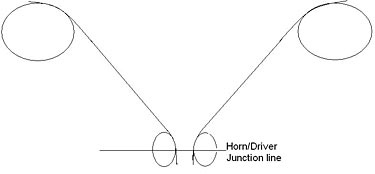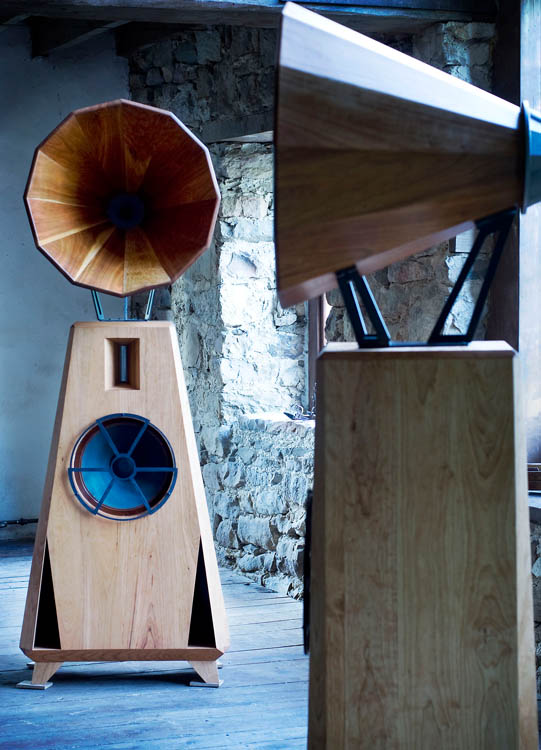An externally hosted image should be here but it was not working when we last tested it.
Concept:
Solid wood baffle, with turned 15" wooden OSWG profile waveguide and a 15" open baffle woofer.
So far in the running is an eminence Alpha 15a for the low end and a Radian 475pb for the top.
OWSG could be increased to 18" if needed, baffles are simply what looked about right, nothing yet modelled.
Any thoughts and recommendations?
I see a couple of issues, some are possible problems and some are problems.
#1 You will have limited output below 40 hz, which may or may not be ok.
#2 You want to push an alpha very high. Keep in mind that not only does the alpha have a huge peak at 2 khz
#3 Most importantly you will hit dipole peak in the middle of the working range of the Alpha. It would be much better if you could transition to a say 8 inch midrange with a smaller baffle before hitting the compression driver. If you do it like that then you will have large peaks and nulls in the response of the alpha, the first null probably at about 200 hz at 0 degrees.
#1 You will have limited output below 40 hz, which may or may not be ok.
#2 You want to push an alpha very high. Keep in mind that not only does the alpha have a huge peak at 2 khz
#3 Most importantly you will hit dipole peak in the middle of the working range of the Alpha. It would be much better if you could transition to a say 8 inch midrange with a smaller baffle before hitting the compression driver. If you do it like that then you will have large peaks and nulls in the response of the alpha, the first null probably at about 200 hz at 0 degrees.
more woofers...
more large bafle for the horn if OSWG can't go below 1000 hz ?
Radian 745 neoPB at 600 ? (less ? distorsion ? dont know ?) ?
A light mms 12" mid below ? or heavy 12" Beyma > 100 hz ?
1 or 2 Emminence Delta lite 2 below (see Troels OBL-11) for bass < 100 hz ? with sides (U-Frame)
more large bafle for the horn if OSWG can't go below 1000 hz ?
Radian 745 neoPB at 600 ? (less ? distorsion ? dont know ?) ?
A light mms 12" mid below ? or heavy 12" Beyma > 100 hz ?
1 or 2 Emminence Delta lite 2 below (see Troels OBL-11) for bass < 100 hz ? with sides (U-Frame)
Last edited:
If sub region was handled by dedicated subwoofers, and the B&C driver used by Gedlee was used crossed at around 1Khz, could a decent 12" or 15" play nice OB up to that point.
I don't have a problem with using more drivers, but if it can be achieved with less complexity, less parts and ultimately less cost then all the better.
I don't have a problem with using more drivers, but if it can be achieved with less complexity, less parts and ultimately less cost then all the better.
Certainly not a 15" (cause the directivity), a 12 or a 10" with EQ because the loss of the dipole... (linkwitz transform here ?)
The 2 Eminence Delta lite is for bass > 40 hz, it's enough and better IMO for most domestic room (which size is yours?), like the jamo, but you can use a U-Frame here with a single maybe (Troels use a small sides for the Delta in his OBL-11).
More seriously I will go for its design if you want an OB (Delta + Jantzen mid) to minimise deception and put your XO at 1K for the OSWG with the CD you want. Note I never try before...don't see many Horns + OB here.
The 2 Eminence Delta lite is for bass > 40 hz, it's enough and better IMO for most domestic room (which size is yours?), like the jamo, but you can use a U-Frame here with a single maybe (Troels use a small sides for the Delta in his OBL-11).
More seriously I will go for its design if you want an OB (Delta + Jantzen mid) to minimise deception and put your XO at 1K for the OSWG with the CD you want. Note I never try before...don't see many Horns + OB here.
An externally hosted image should be here but it was not working when we last tested it.
Concept:
Solid wood baffle, with turned 15" wooden OSWG profile waveguide and a 15" open baffle woofer.
So far in the running is an eminence Alpha 15a for the low end and a Radian 475pb for the top.
OWSG could be increased to 18" if needed, baffles are simply what looked about right, nothing yet modelled.
Any thoughts and recommendations?
Why not copy some of the Emerald Physics designs?
Basically the same idea right?
I considered them quite seriously before I ended up buying Summas.
http://www.emeraldphysics.com/2011/01/cs23.html
Actually, it just occurred to me that the design I'm working on myself has a lot in common with the Emerald Physics.


The older Emerald Physics speakers used a waveguide for 1khz and above, and 15" woofers for 1khz and down.
In this respect, they're similar to my Summas, but the Summas are a monopole and the EPs are dipole.
In the pic above, you can see the similarities. To me, it appears that Emerald Physics was using an Eminence Alpha 15, a Dayton waveguide, and an unknown compression driver. The Geddes speakers use custom waveguides, B&C woofers and compression drivers.
An externally hosted image should be here but it was not working when we last tested it.
The new Emerald Physics speakers use a coax now. This has a few advantages:
I like the sound of my Summas, but you need a big room. This is due to the large spacing between woofer and compression driver. The gap between the woofer and compression driver is over a foot, and due to that gap, you need to sit a ways back to get into the farfield. Substituting a coax for the waveguide solves that problem, while creating some new ones.
In my new speaker, I'm using a Synergy horn for the midrange and tweeter, but the idea is basically the same. A Synergy horn will likely have better polar response and smoother frequency response than a coax, but a coax is a good solution too.
The speaker that I'm working on is documented in the thread named "Monster Massive."
Last edited:
This i guess was inspired primarily by The Summa, and how to integrate such a large waveguide perhaps 18" into something that doesn't become the size of a small car.
If emerald physics ran the Alpha's close to 1khz, maybe its possible.
Anyone know of a piece of software to model OB with?
If emerald physics ran the Alpha's close to 1khz, maybe its possible.
Anyone know of a piece of software to model OB with?
This i guess was inspired primarily by The Summa, and how to integrate such a large waveguide perhaps 18" into something that doesn't become the size of a small car.
If emerald physics ran the Alpha's close to 1khz, maybe its possible.
Anyone know of a piece of software to model OB with?
If I've understood correctly one of the reasons the Summa is so large is that Geddes has 110 + dB as his goal SPL. If you don't need that ( Your ears will thank you!
This B&C 10" coaxial for example looks nice:
Last edited:
Hi Dennis, I drew up plans to turn segmented OSWG horns, I found a calculator, not sure where now, if I find it in my history I will post a link.
A lot of info here:

They are relatively simple in principal. I planned to either turn them like segmented rings, or perhaps cut 12 triangle sections with 15* bevel, glue up and turn the internal profile.
Similar to how these are made

18" seemed to be the holy grail of OSWG waveguide size, but rather impractical to manufacture, unless you have a workshop and a fair bit of time...
A lot of info here:

They are relatively simple in principal. I planned to either turn them like segmented rings, or perhaps cut 12 triangle sections with 15* bevel, glue up and turn the internal profile.
Similar to how these are made

18" seemed to be the holy grail of OSWG waveguide size, but rather impractical to manufacture, unless you have a workshop and a fair bit of time...
Found them.
Here are the two spreadsheets I used.
https://dl.dropboxusercontent.com/u/1444609/diyaudio/2013/Geddes.xls
https://dl.dropboxusercontent.com/u/1444609/diyaudio/2013/OS%20WG%202.xls
All credit goes to their creators (which I think are named within)
Here are the two spreadsheets I used.
https://dl.dropboxusercontent.com/u/1444609/diyaudio/2013/Geddes.xls
https://dl.dropboxusercontent.com/u/1444609/diyaudio/2013/OS%20WG%202.xls
All credit goes to their creators (which I think are named within)
Beautifull speakers, big toy for men, ready for WAF approval !
Like the embeded horn for the ribbon ! We have maybe here a 1/4 or 2" CD + tweeter + Bass-mid.
Patrick Bateman, you write something very interesting : you say that you need always a big distance between the listener and the Sumas for a good fusion of the OSWG and Midbass...(I understand : like any of the others horns systems). Which is this minimum distance in your listening room between the sweet spot and Sumas for good results ?
Like the embeded horn for the ribbon ! We have maybe here a 1/4 or 2" CD + tweeter + Bass-mid.
Patrick Bateman, you write something very interesting : you say that you need always a big distance between the listener and the Sumas for a good fusion of the OSWG and Midbass...(I understand : like any of the others horns systems). Which is this minimum distance in your listening room between the sweet spot and Sumas for good results ?
This i guess was inspired primarily by The Summa, and how to integrate such a large waveguide perhaps 18" into something that doesn't become the size of a small car.
If emerald physics ran the Alpha's close to 1khz, maybe its possible.
Anyone know of a piece of software to model OB with?
As someone who owns a Summa, please don't use a waveguide bigger than 30cm unless you have a very big room. If I had to do it over again I'd go with the 30cm variation from Geddes; the Summa is too big for a small to medium size room. (My room is about 3.3 meters deep.)
I didn't buy the Summa because I wanted the top of the line, I bought the Summa because Geddes had a huge waiting list for the less expensive models and I had money burning a hole in my pocket.
A coaxial solves most of this, because it gets the midrange and tweeter close together. But it also introduces some other problems.
This interview with Andrew Jones from TAD really covers the material nicely. He explains why coaxes solve a lot of headaches. If I'm not mistaken, Jones also worked for Kef on the UNI-Q:
Serious Audio: Interesting Podcast: Andrew Jones of TAD/Pioneer
The two best programs for modeling dipoles and cardioids are the mathcad worksheets from John Kreskovsky at FRD Consortium, and Tolvan's 'The Edge.'
Note that Kreskovsky has backed away from the U-Frame software a bit, as he's mentioned on the forum that fiberglass stuffing is hard to simulate, so the U-Frame sims and the U-Frame reality changes dramatically when stuffed.
You're about to dive into a fun rabbit hole though, I'm pretty sure that dipoles and cardioids are one of the most maddening designs in audio
Beautifull speakers, big toy for men, ready for WAF approval !
Like the embeded horn for the ribbon ! We have maybe here a 1/4 or 2" CD + tweeter + Bass-mid.
Patrick Bateman, you write something very interesting : you say that you need always a big distance between the listener and the Sumas for a good fusion of the OSWG and Midbass...(I understand : like any of the others horns systems). Which is this minimum distance in your listening room between the sweet spot and Sumas for good results ?
The further the better really. My Summas sound dramatically better in a big room. We're talking night and day difference.
My Summas are in my bedroom at the moment, and my Vandersteens are in my living room. (WAF and all that.)
With the Vandersteens, you can listen at almost any distance because the gap between the midrange and the tweeter is about 13cm. At the same time, the Vandersteens don't really like to be played loud. First order crossovers and a 1" tweeter aren't a recipe for high SPL.
The Summas on the other hand just BEG YOU to turn up the volume. While their efficiency isn't as high as you might expect (due to the frequency contouring required by an OS waveguide) their power handling and displacement is re-donk-u-lous.
Put those two things together, and the Summas are a speaker that like a surprising big amp and a big room.
I hope I don't scare people off from buying Summas. They're a great speaker, just don't put them in a tiny room like mine. If your room ISN'T big, get the smaller model. What have you got to lose? The only compromise in the Abbey is that the directivity narrows at 1125hz instead of 900hz. Do you really think you'll hear a difference?
- Status
- This old topic is closed. If you want to reopen this topic, contact a moderator using the "Report Post" button.
- Home
- Loudspeakers
- Multi-Way
- 15" OSWG & 15" OB 4 ME